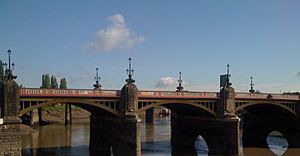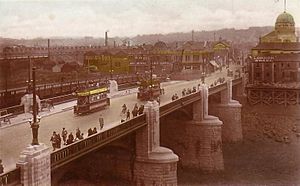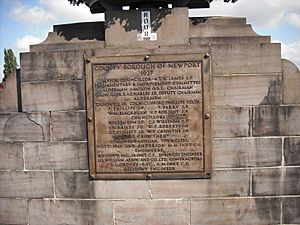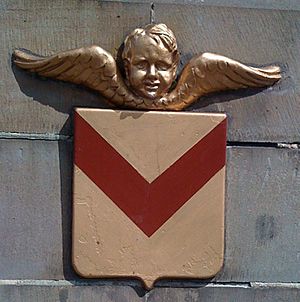Newport Town Bridge facts for kids
Quick facts for kids Newport Bridge |
|
|---|---|

Newport Bridge in 2011.
|
|
| Carries | Motor vehicles, cyclists and pedestrians |
| Crosses | River Usk |
| Locale | Newport |
| Official name | Newport Bridge |
| Maintained by | Newport City Council |
| Characteristics | |
| Design | Five-span arch bridge |
| Total length | ? feet (? metres) |
| Width | Four-lane carriageway, two cycle/footpaths |
| Longest span | ? m (? ft) |
| History | |
| Opened | 22 June 1927 |
The Newport Bridge, also known as the Town Bridge, is a famous bridge in Newport, Wales. It opened in 1927 and crosses the River Usk. This bridge connects the High Street and Clarence Place with important places like Newport Castle and the Newport city centre. It's a busy spot for cars, bikes, and people walking.
Contents
Newport Bridge: Connecting the City
The First Stone Bridge (1800)
Long ago, the first stone bridge at this spot was built in 1800. It had five arches and was made by David Edwards and his sons. Later, in 1866, the bridge was made wider. They added special paths on both sides for people to walk on.
A special stone from this old bridge can still be seen today. It's at Caerleon Bridge and tells us when the bridge was finished.
Boats and Blue Plaques
Have you ever heard of a blue plaque? It's a special sign that tells us about important history. On the Newport Bridge, there's a blue plaque that reminds us of the old days. It tells us that Paddle steamers, which are boats powered by large wheels, used to sail from nearby.
These famous white-funnel boats, run by P&A Campbell, started sailing in the 1880s. They were very popular for many years before stopping in the 1950s.
Harry Houdini's Daring Jump
On March 5, 1913, a very famous escape artist named Harry Houdini visited Newport. He was known for his amazing tricks! Houdini jumped off the Newport Bridge with his hands and feet locked in chains.
The police tried to stop him, but he quickly took a taxi to the other side of the bridge and jumped. The next week, the police arrested him. They said he was blocking the road and putting on a show without permission.
Building a Brand New Bridge
By 1911, the Newport Town Council realized they needed a new bridge. The old one was getting too old and small for the growing city. In 1923, they decided to build a new bridge right away. This project also helped many people find work during a time when jobs were hard to get.
How the New Bridge Was Built
To build the new bridge, workers first put up a temporary wooden bridge next to the old one. All the important pipes and wires, like gas and electricity, were moved onto this temporary bridge. Even the city's tram tracks and their power lines were moved!
Once everything was safely moved, the old bridge was taken down. Then, the new, stronger bridge was built in its place. On June 22, 1927, the new Newport Bridge was finally finished. A special guest, the Transport Minister Wilfrid Ashley, officially opened it to traffic.
Golden Cherubs and Rock Music
If you look closely at the new bridge, you'll see something special. On four of its pillars, there are stone figures called cherubs. These cherubs are painted gold and hold shields. The shields show the coat of arms of Newport, which is like the city's special symbol.
These cherubs even inspired a famous rock band! In 1994, John Squire, the guitarist for The Stone Roses, designed the cover for their song "Love Spreads". He based it on a photograph of one of these cherubs from the Newport Bridge. That song became a huge hit for the band! The cherub design also appeared on many items for their album Second Coming.
More to Explore
- List of bridges in Wales
- Newport and Caerleon Bridges over Usk Act 1597




